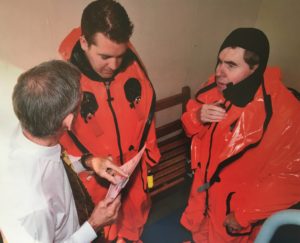David White – Escaping from a submarine at 400 feet deep
So every, you know, four or five years I think, we would prove to ourselves, to the Fleet and to, most importantly, to Submariners, that the system actually works so we would go …
So, we’d take it to sea on a running submarine and show the whole Submarine Service that it works because it gets trumpeted, let people know. So, off we go, and we go up to somewhere in Scotland, to a Loch so you’re not worried too much about tides and things like that so it’s very controlled and the submarine will go along and bottom, normally at about 400 feet. If you go deeper, there is a depth below which it becomes experimental, or trials and they have to pay you extra money which they don’t like to do.
It’s bad enough they’re already giving you Tank pay, so they bottom out at around about, I think when I did it, it was 408 feet and then, maybe a dozen Instructors will then do the escape and we also say to the crew, “If anybody wants to have a go, you can.” So, you normally start off at about 200 feet, so you do your escapes there, so you’ve got everything up top; you’ve got a Safety Boat, you’ve got a Recompression Chamber and everything you’ll need if anything should go wrong, and then you work your way down and we got down to …
Simon: So then it comes, the submarine comes back up, picks you up?
Submarine comes up. You all go back onboard, back down and do it again.
And that was great fun and that was spectacular, so you go into the escape tower, this, 400 feet right. So, you check your suit like a paratrooper checks his parachute I imagine.
The last thing you want is tears, holes, anything that’s going to lose this air sack that you’re going to depend on. I mean it wouldn’t be the end of the world if it ripped because you’d go back to Phase 1 and blow out to the surface.
So, you check your suit and then when your turn comes you come in and the first time you do it of course you’re nervous, you’re doing it in a nice warm Tank, now it’s 400 feet in the ocean or …
Simon: And pitch dark as well.
Oh you don’t know a darkness like it and that’s the other point I was going to make so you flood up, you know it’s …the thing you have to realise is how quickly you must be pressurised because you cannot spend, at 600 feet you’ve got 18 seconds to pressurise and make a direct ascent. Any longer than that, you’re gonna get the bends.
So if you start having pains with your ears they can’t stop. Oh, you can in trials, you can hammer and they’ll stop and drain you down, but the real thing, you just suck it up, and I mean burst eardrums isn’t the end of the world.
Simon: Relatively, yes.
They heal in about four, five weeks. Your hearing’s very rarely impaired and a very small price to pay to get out of a submarine, so it’s very short, sharp pain and then they’re free flood.
It’s easy after that, it’s bliss when they go because then you don’t even have to clear your ears anymore. So, you climb in the Tower, they clang when they shut that lower lid and you think, ‘Oh what am I doing here?’
You plug in and then you two bangs is enough, it starts to flood and you’ve got a little vent pipe so you keep an eye on that and as soon as the water gets up to that level they shut it inside the submarine and that’s when pressure comes on you and you’re really pumping, and then all of a sudden you feel a cascade of water comes in, ‘coz what’s happened is you’ve equalised, maybe the water’s three or four feet below the hatch, but equalisation has happened, they’ve wound the hatch open, it’s also spring-loaded and you feel all the water gush in and then wild horses wouldn’t stop you ‘coz you’ve got all this buoyancy in there so bang, out you go.
Simon: Is there someone feeding you out?
No, no, no, it’s only a single tower, one man in it. So now you’re hurtling somewhere. You know you’re going fast, but you don’t know if you’re doing that, that, or even that, so what we were told to do by blokes who’d done it before, is cross your legs and that’ll make you rifle up.
Simon: Oh, spin round.
‘Cos you could easily go up like that, well somewhere up there is the very hard hull of a ship.
Which you really don’t want to hit, so they said, “Cross your feet and keep your hands tight to your sides and you will spiral and it will make you.” So now you’re hurtling up …
Simon: Are you feeling dizzy when you’re spinning around?
No, no, no, no, no, and it’s … I mean we all did it, as we come out, hold on, try, to experience that dark that might I be out of the sea, part of the submarine but it’s black, it’s a blackness you can’t imagine.
So, now you’re hurtling up through the water at about 11 feet a second and then out the top of your visor you see this green glimmer and it gets brighter and brighter, bright, bright, bright, bright, and then and you pop out like a Polaris missile and flop back down in the water.
Simon: Are you, so what you literally come out the water do you?
Oh yeah, by certainly more, just, more than your waist. 11 feet a second, you pop and then the first thing you do is hold your hand up to show you’re alright and then a Gemini comes and drags you unceremoniously in and they take you straight back to Gemini, unzip you and sit you by the Recompression Chamber for two minutes to make sure you’ve got no adverse reactions.
Simon: And, and, you’re sort of having some trepidation before doing it?
Oh yeah absolutely.
Simon: Even though you’re totally trained?
Yeah, yeah. You’re the Trainer but this is the first time you’ve done it in cold, dark water. You know, but yeah, it was exhilarating, there’s no other word for it. And you know, something I’m very, very proud of.







